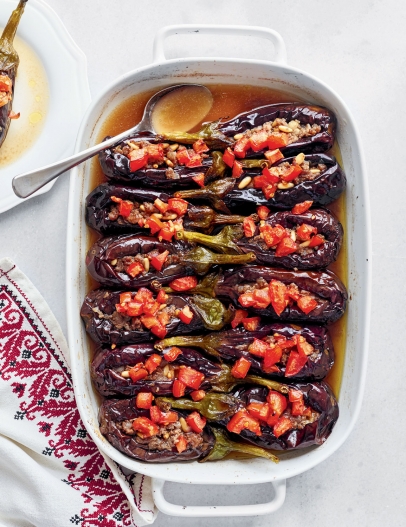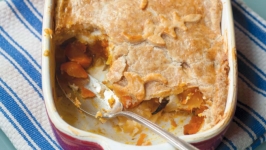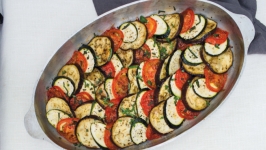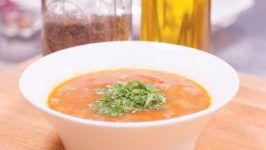Stewed and Stuffed
A different take on summer vegetables
I LOOKED AT MY WATCH. IT WAS 12:45PM.
It would be tight, but if I played it right, I was pretty sure I could make it to the Italian Market and back to the Rittenhouse area just in time to pick up my daughters from school.
There was nothing I needed urgently—I had actually just spent the morning at the supermarket—but going to the 9th Street market is a small obsession of mine. It’s the only place in Center City where I can find what Mexicans call “gray squash,” Italians call “white zucchini” and we Palestinians call “koosa.”
Koosa, which resembles the standard green zucchini in shape but is much lighter in color and about half the size, is one of the most, if not the most, widely stuffed vegetables across the Middle East. But we Palestinians, and all Middle Easterners, in fact, stuff a wide range of vegetables, from carrots, cucumbers, eggplants and zucchini to tomatoes, potatoes, bell peppers, onions, cabbage and grape leaves.
As for the cooking method and sauces, there is also a lot of variation. Cucumber, for example, is given more flavor by cooking it in a tamarind sauce, while the traditional squash is cooked in either a tomato sauce or yogurt sauce. Both of these examples are cooked on the stovetop, whereas eggplants are often braised in the oven with a simple broth flavored with pomegranate molasses.
We normally think of braised dishes as winter meals. In the Middle East, however, stuffed vegetables are staples year-round, with the majority of vegetables we stuff being in the height of season during the summer—think eggplants, tomatoes, and zucchinis.

Here in the West, we normally think of braised dishes as winter meals. In the Middle East, however, stuffed vegetables are staples year-round, with the majority of vegetables we stuff being in the height of season during the summer—think eggplants, tomatoes and zucchinis.
While it seems counterintuitive to want to eat warm foods, particularly stuffed and stewed vegetables, in the summer, warm foods are actually easier and quicker to digest. Since the Middle Eastern versions of these dishes are also mostly vegetable-based with meat playing only a supporting role, they actually help you feel full without feeling overly heavy or exhausted in the heat. In addition, yogurt is almost always served alongside all these meals, balancing out the cold and warm components while enhancing flavor and aiding with digestion.
But it’s not just about the temperature and the broth.
Our current tendency is to value crisp-tender, barely cooked vegetables, which is the influence of nouvelle French cuisine on our perception of what constitutes good or correctly cooked foods. Yet in many cultures, from Italian to Middle Eastern, the norm has traditionally been to cook vegetables way past that point, until they are rendered soft in slow simmering broths or baths of olive oil.
Cooking this way does not make vegetables bitter or soggy. To the contrary, cooking them enough to break down the natural sugars inside without discarding the cooking liquid yields delectable dishes that are easier to digest. Our bodies also more easily absorb the nutrients from vegetables cooked this way. It’s a win-win situation. The first references to stuffing food in Arabic cuisine date back to the 10th century. The items stuffed, the flavoring and cooking methods may have evolved over time, but it’s easy to see why this method of cooking has appealed to Ottomans, Arabs and many other cultures for centuries now.
The stuffing itself can vary as can the method of cooking. Sometimes the stuffing is a mixture of rice and meat, other times, it’s a spiced ground meat, onion and pine nut mixture called hosseh, and other times still it’s a vegetarian stuffing of bulgur, tomatoes and herbs.
This method of cooking is not only aesthetically pleasing and enjoyable to eat—the vegetables retain their original shape throughout cooking, as they are hollowed and the cavity stuffed— it is also a very easy way to get a varied set of vitamins, minerals and proteins all from one dish. In addition, although they tend to be time consuming dishes to make, it’s often a group eff ort, where multiple women would sit together preparing the dish, making the entire process of cooking and eating an enjoyable social affair.
I’m not encouraging you to rush to the 9th Street Italian market like me to satisfy a craving for stuffed vegetables. (I made it back home with 10 minutes to spare!) But next time you want to cook a meal with friends, or find yourself in a farmers’ market and come across fresh, seasonal vegetables during the summer, consider an alternative preparation and stuff them for a truly satisfying and complete meal that can bring people together in more ways than one.









